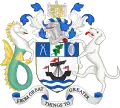Bethnal Green
Bethnal Green is an area in the East End of London, England, 3 miles (4.8 km) northeast of Charing Cross. The area emerged from the small settlement which developed around the Green,[2] much of which survives today as Bethnal Green Gardens, beside Cambridge Heath Road. By the 16th century the term applied to a wider rural area, the Hamlet of Bethnal Green, which subsequently became a Parish, then a Metropolitan Borough before merging with neighbouring areas to become the north-western part of the new London Borough of Tower Hamlets.
| Bethnal Green | |
|---|---|
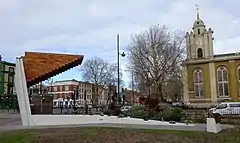 Stairway to Heaven, also seen is Bethnal Green tube station, CoE St John Church and Salmon and Ball public house. | |
 Bethnal Green Location within Greater London | |
| Population | 27,849 (Bethnal Green North and Bethnal Green South wards 2011)[1] |
| OS grid reference | TQ345825 |
| • Charing Cross | 3.3 mi (5.3 km) SW |
| London borough | |
| Ceremonial county | Greater London |
| Region | |
| Country | England |
| Sovereign state | United Kingdom |
| Post town | London |
| Postcode district | E1, E2 |
| Dialling code | 020 |
| Police | Metropolitan |
| Fire | London |
| Ambulance | London |
| UK Parliament | |
| London Assembly | |
Economic focus shifted from mainstream farming produce for the City of London – through highly perishable goods production (market gardening), weaving, dock and building work and light industry – to a high proportion of commuters to city businesses, public sector/care sector roles, construction, courier businesses and home-working digital and creative industries. Identifiable slums in the maps of Booth in Life and Labour of the People in London (3 editions, 1889–1903) were in large part cleared before the aerial bombardment of the Second World War which accelerated clearance of many tightly packed terraces of small houses to be replaced with green spaces and higher-rise social housing.
Toponymy
The topographer Daniel Lysons suggested in the late 18th century that Bethnal was a corruption of Bathon Hall which would have been the residence of a notable Bathon family who owned large parts of Stepney, the parish of which Bethnal Green was part. "Green" related to one which lay "about half a mile beyond the suburbs".[3]
More recently it has been suggested that the name could be a derivation of the Anglo-Saxon Blithehale or Blythenhale from the 13th century. healh would have meant "angle, nook, or corner" and blithe would have been the word for "happy, blithe", or come from a personal name Blitha. In either case, the Dictionary of London Place Names supports a contraction involving hall or healh, noting h-dropping in local dialects, to Bethnal Green.[4]
History
Origins and administration
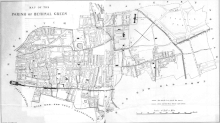
| Bethnal Green Parish Act 1742 | |
|---|---|
| Act of Parliament | |
.svg.png.webp) | |
| Long title | An Act to make the Hamlet of Bethnal Green in the Parish of Saint Dunstan, Stepney, in the County of Middlesex, a separate and distinct Parish, and for erecting a Parish Church therein. |
| Citation | 16 Geo. 2. c. 28 |
| Dates | |
| Royal assent | 21 April 1743 |
The term Bethnal Green originally referred to a small common in the Manor and Ancient Parish of Stepney; around which a small settlement developed. By the seventeenth century the area had become a hamlet, a territorial sub-division of Stepney,[5][6] with a degree of independence. Continued housebuilding and population growth in the 18th century led to the hamlet area becoming a fully independent daughter parish in 1743. The parish had a church, a benefice (for its priest) and vestry (for its people) in 1743. In 1855 Bethnal Green was included within the area of the Metropolitan Board of Works to which it nominated one member and the various local government bodies were replaced by a single incorporated vestry which consisted of 48 elected vestrymen.[7]
Under the Metropolis Management Act 1855, any parish that exceeded 2,000 ratepayers was to be divided into wards; as such the incorporated vestry of St Matthew Bethnal Green was divided into four wards (electing vestrymen): No. 1 or East (9), No. 2 or North (9), No. 3 or West (15) and No. 4 or South (15).[7][8][9]
The (civil) parish became a Metropolitan Borough in 1900, which merged with some of the neighbouring areas, to become the new London Borough of Tower Hamlets, in 1965.
The area was part of the historic (or ancient) county of Middlesex, but military and most (or all) civil county functions were managed more locally, by the Tower Division (also known as the Tower Hamlets).
The role of the Tower Division ended when Bethnal Green became part of the new County of London in 1889. The County of London was replaced by Greater London in 1965.


Early history
_in_the_grounds_of_the_former_London_Chest_Hospital_02.jpg.webp)
In what would become northern Bethnal Green (known as Cambridge Heath) a tract of common land, which stretched to the east and west, a part of the Manor and Ancient Parish of Stepney. The heath was used as pasture where people grazed their sheep in the 13th century, though 1275 records suggest at least one house stood there.[10] Stepney's Manor House (known as Bishopswood, later Bishop's Hall) was located in Bethnal Green from at least 1207,[11] on a site subsequently occupied by the London Chest Hospital.
Blind Beggar of Bethnal Green
The area was once best known for the popular early modern ballad, The Blind Beggar of Bethnal Green, which tells the story of a beautiful young woman named Bess, the daughter of a blind beggar. The earliest known explicit mention of the ballad is from 1624, but it was clearly well established by that date, as two other ballads of similar date were said to have been sung to the tune of the Blind Beggar. A play on the same theme, almost certainly based on an existing ballad, is known to have been performed in 1600.[12]
According to one version of the legend, found in Thomas Percy's Reliques of Ancient English Poetry published in 1765, the beggar was said to be Henry, the son of Simon de Montfort, but Percy himself declared that this version was not genuine.[13] A version published in 1934,[14] closely based on Percy's but with some amendments to include much older material, contains 67 verses. The ballad recounts how Bess leaves Bethnal Green to seek her fortune, and stays a short time at the Queen's Arms inn at Romford. There, her beauty quickly attracts four suitors, three of whom lose interest when she declares her background, while the fourth, a knight is unconcerned by her father's status. The couple marry, and despite his seeming poverty, the beggar gives a huge dowry to the knight, to the bitter dismay of the other three suitors. The Blind Beggar public house, just on the Bethnal Green side of the historic boundary with Whitechapel,[15] is reputed to be the site of his begging.
A depiction of the beggar is known to have been used on the head of the local beadle's staff in 1690.[16][17] Later, the beggar and his daughter were the basis of the common seal of the Metropolitan Borough of Bethnal Green.[18] The legend also inspired Elisabeth Frink's sculpture Blind Beggar and his Dog (1958) on the Cranbrook Estate in Bethnal Green.
Mulberry
Bethnal Green is famous for its mulberry trees, most notably the Bethnal Green mulberry at the site of the former London Chest Hospital, which is reputed to be the oldest tree in the East End. Many of these mulberry trees may be a legacy of unsuccessful 16th and 17th century attempts to boost the weaving industries that Bethnal Green, Shoreditch, Spitalfields and other East End districts relied upon so heavily.[19]
Mulberries were used as the local emblem when it was a partly self-governing neighbourhood of Tower Hamlets from 1986-1992, and the symbol can still be seen on many local street signs.[20] The mulberry is also used as a symbol of the East End more generally, and is featured on the coat of arms of the London Borough of Tower Hamlets.
Growth
.jpg.webp)
The Green and Poor's Land is the area of open land now occupied by Bethnal Green Library, the Young V&A and St John's Church, designed by John Soane. In John Stow's Survey of London (1598) the hamlet was called Blethenal Green. It was one of the hamlets included in the Manor of Stepney and Hackney. Hackney later became separated. In 1678, the owners of houses surrounding the Green purchased the land to save it from being built on and in 1690, the land was conveyed to a trust under which it was to be kept open and rent from it used for the benefit of poor people living in the vicinity. From that date, the trust has administered the land and its minute books are kept in the London Metropolitan Archives. Bethnal House, or Kirby's Castle, was the principal house on the Green. One of its owners was Sir Hugh Platt (1552–1608), author of books on gardening and practical science. Under its next owner it was visited by Samuel Pepys. In 1727 it was leased to Matthew Wright and for almost two centuries it was an asylum. Its two most distinguished inmates were Alexander Cruden, compiler of the Concordance to the Bible, and the poet Christopher Smart. Cruden recorded his experience in The London Citizen Grievously Injured (1739) and Smart's stay there is recorded by his daughter. Records of the asylum are kept in the annual reports of the Commissioner in Lunacy. Even today, the park where the library stands is known locally as "Barmy Park". The original mansion, the White House, was supplemented by other buildings. In 1891, the Trust lost the use of Poor's Land to the London County Council. The asylum reorganised its buildings, demolishing the historic White House and erecting a new block in 1896. This building became the present Bethnal Green Library. A history of Poor's Land and Bethnal House is included in The Green, written by A.J. Robinson and D.H.B. Chesshyre.
Boxing has a long association with Bethnal Green. Daniel Mendoza, who was champion of England from 1792 to 1795 though born in Aldgate, lived in Paradise Row on the western side of Bethnal Green for 30 years. Joe Anderson, 'All England' champion of 1897, was from Bethnal Green.[21]
The north end of the Green is associated with the Natt family. During the 18th century they owned many of its houses. Netteswell House is the residence of the curator of the Bethnal Green Museum. It is almost certainly named after the village of Netteswell, near Harlow, whose rector was the Reverend Anthony Natt. A few of its houses have become University settlements. In Victoria Park Square, on the east side of the Green, No. 18 has a Tudor well in its cellar.[22]
The silk-weaving trade spread eastwards from Spitalfields throughout the 18th century. This attracted many Huguenot and Irish weavers to the district. Large estates of small two-storey cottages were developed in the west of the area to house them. A downturn in the trade in 1769 led to the Spitalfield Riots, and on 6 December 1769, two weavers accused of "cutting" were hanged in front of the Salmon and Ball public house.
Bethnal Green Road Market on the road of the same name, founded in the 18th century, grew and grew and became more full with stalls. By 1959 stalls were choking the streets and the council attempted to relocate the market but had no success. In 1986 there had been many shop closures but the stalls were still trading. The street market is now today recognised as a major local shopping area.[23]
Victorian era
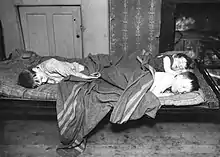
In the 19th century, Bethnal Green remained characterised by its market gardens and by weaving. Having been an area of large houses and gardens as late as the 18th century, by about 1860 Bethnal Green was mainly full of tumbledown old buildings with many families living in each house. By the end of the century, Bethnal Green was one of the poorest slums in London. Jack the Ripper operated at the western end of Bethnal Green and in neighbouring Whitechapel. In 1900, the Old Nichol Street rookery was replaced with the Boundary Estate (near the limits of Shoreditch). This was a first in council housing. Brothers Lew Grade and Bernard Delfont were brought up on the estate.[24] In 1909, the larger Bethnal Green Estate was opened with money left by the philanthropist William Richard Sutton which he left for "modern dwellings and houses for occupation by the poor of London and other towns and populous places in England".[25][26] The Peabody Trust administered the funds to complete much of the estate in 1910.[27]
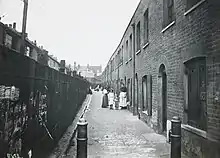
The Regent's Canal opened in 1820, for horse-drawn canal barges to carry cargo between the London Docklands and the Grand Union Canal. These supplied local coal merchants and gas houses/plants (gasifiers) built along its banks including Bethnal Green.[28]
The London Society for Promoting Christianity among the Jews built Palestine Place as Cambridge Heath began to be fully developed during the first half of the 19th century. A windmill survived until at least 1836. Most local residents were poor, especially in the streets around the railway line and the Regent's Canal, as well as on Russia Lane.
In 1841, the Anglo-Catholic Nathaniel Woodard, who was to become a highly influential educationalist in the later part of the 19th century, became the curate of the newly created St. Bartholomew's in Bethnal Green. He was a capable pastoral visitor and established a parochial school. In 1843, he got into trouble for preaching a sermon in which he argued that The Book of Common Prayer should have additional material to provide for confession and absolution and in which he criticised the "inefficient and Godless clergy" of the Church of England. After examining the text of the sermon, the Bishop of London condemned it as containing "erroneous and dangerous notions". As a result, the bishop sent Woodard to be a curate in Clapton.
Globe Town was established from 1800 to provide for the expanding population of weavers around Bethnal Green attracted by improving prospects in silk weaving. The population of Bethnal Green trebled between 1801 and 1831, operating 20,000 looms in their own homes. By 1824, with restrictions on importation of French silks relaxed, up to half these looms became idle and prices were driven down. With many importing warehouses already established in the district, the abundance of cheap labour was turned to boot, furniture and clothing manufacture. Globe Town continued its expansion into the 1860s, long after the decline of the silk industry.[29]
Columbia Road Flower Market is on the street of the same name which has kept some Victorian shops, and was established as Columbia Market in 1869 as a covered food market. It closed in 1886, but was later revived as a Sunday flower market.[30][31]
Bethnal Green Junction, now just Bethnal Green from 1946 (which leads to confusion with the much-later London Underground station) and Cambridge Heath railway station are on the London Overground. Both were opened by the Great Eastern Railway (GER) on the Lea Valley Lines in 1872 as part of a more direct route to Enfield Town. The GER opened further Fast Lines that allow longer-distance trains to bypass these.[32][33][34] Bethnal Green was also formerly served by trains on the Great Eastern Main Line (GEML) via Stratford and saw two derailments in the later 20th century, similar to other contemporary comparators of busy, metropolitan junctions.[35][36]
Mowlem Street School opened in 1887. It was enlarged in 1898 and again in 1902 to accommodate 410 boys and 410 girls. A new single-storey building catering for 280 children was opened in 1971 when it was renamed Mowlem Primary School.[37]
Early 20th century
St Casimir's was founded in 1901, with a church on the corner of Christian Street and Cable Street. Fr. Boleslas Szlamas had his quarters at 197 Whitechapel Road. The present church dates from ten years later, during the rectorate of Fr. Casimir G. Matulaitis. It was opened by Cardinal Bourne on 10 March 1912. The Mass on this occasion was said by Fr. Benedict Williamson, who was the architect of the church.[38]
Bethnal Green Town Hall was completed in 1910[39] and the internationally renowned York Hall opened in 1929 with a capacity of 1,200.[40] Later, in 1993, the Town Hall was vacated when the London Borough of Tower Hamlets moved its headquarters, and in 2007 the building was converted to a hotel which opened in 2010.[41]
The warehouse buildings rose from the Regent's Canal without a towpath to interrupt development, giving direct access to the canal. A row of Victorian workshops was built on Wadeson Street in what was a historically Jewish precinct. This became very overcrowded with 572 inhabitants living in 125 houses by the 1930s.[42]
The Blitz
During the Second World War, the Luftwaffe began The Blitz on 7 September 1940. Bethnal Green was in "Target Area A" along with the rest of the East End of London.[43]
Bethnal Green Library was bombed on the very first night of the Blitz. This forced the temporary relocation of the library into the unopened Bethnal Green Underground Station in order to provide continuity of lending services. The library was rebuilt and opened a few months later for the public.[44] Oxford House also had a major role, with some local residents fleeing into the house off Bethnal Green Road seeking shelter, this location was more attractive than the stables under the nearby Great Eastern Main Line arches. The Chief Shelter Welfare Officer at the time, Jane Leverson, is reported to have said that "people came to Oxford House not because it was an air raid shelter but because there they found happiness and a true spirit of fellowship".[45]
It is estimated that during this war, 80 tons of bombs fell on the Metropolitan Borough of Bethnal Green, affecting 21,700 houses, destroying 2,233 and making a further 893 uninhabitable. There were a total of 555 people killed and 400 seriously injured.[46] Many unexploded bombs remain in the area, and on 14 May 2007, builders discovered a Second World War 1 m long 500 lb (230 kg) bomb.[47]
Bethnal Green tube disaster
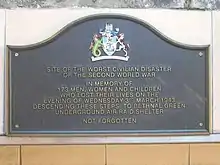
On 3 March 1943, the air-raid Civil defence siren sounded at 8:17 pm, causing a flow of people down the staircase which had no lights on from the street level into the incomplete Bethnal Green tube station, which had been requisitioned in 1940 by the Metropolitan Borough of Bethnal Green under the supervision of the Regional Commissioners. The panic itself began at 8:27 coinciding with the sound of an anti-aircraft battery (possibly the recently installed Z battery) being fired at nearby Victoria Park. In the wet, dark conditions the crowd was surging forward towards the shelter when a woman tripped on the stairs, causing many others to fall. Within a few seconds 300 people were crushed into the tiny stairwell, resulting in the deaths of 173 people (most of whom were women and children) who were crushed and asphyxiated. Although a report was filed by Eric Linden with the Daily Mail, who witnessed it, the report was never published. Very little information was provided at the time.[48][49][50] The results of the official investigation were not released until 1946.[51] It was the largest loss of life in a single incident on the London Underground network.[52]
Post-war
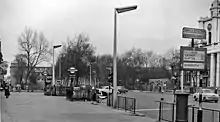
Bethnal Green tube station opened on 4 December 1946 on the Central line and is between Liverpool Street and Mile End on the London Underground, however construction of the Central line's eastern extension into then-Essex was started in the 1930s, and the tunnels were largely complete at the outbreak of the Second World War although rails were not laid.
The book Family and Kinship in East London (1957) shows an improvement in working class life. Husbands in the sample population no longer went out to drink but spent time with the family. As a result, both birth rate and infant death rate fell drastically and local prosperity increased.
The famous criminals, the Kray twins, lived and operated in the area during the 1950s and 1960s, with a gang known as The Firm.[53]
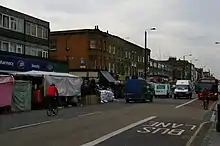
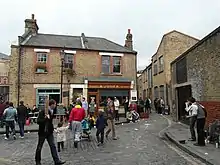
During the 21 July 2005 London bombings, a number 26 bus was targeted by Muktar Said Ibrahim, who attempted to explode a device while the bus was on Hackney Road from Waterloo, near the corner of Columbia Road. The bomb caused a small explosion but did not detonate as intended, and there were no deaths or significant damage.[54]
In 2015, three children Amira Abase, Shamima Begum, and Kadiza Sultana appeared in the press, referred to as the Bethnal Green trio.[55] All three had attended the Bethnal Green Academy before leaving home to join the Islamic State of Iraq and the Levant (ISIL).[56]
Representation

Excluding the five-year tenure of George Galloway at Westminster from 2005, for any seat containing the name Bethnal Green: the pre-1945 General Election decades of Bethnal Green South West was the last time when such a seat was not won by the chosen Labour Party candidate.[57]
Bethnal Green forms part of the UK Parliament constituency of Bethnal Green and Bow. Its MP since 2010 has been Rushanara Ali of the Labour Party.[58]
London overall has a directly elected executive Mayor of London, currently Sadiq Khan and the City and East seat in the London Assembly is held by the Labour Party member, Unmesh Desai.
The area of Bethnal Green covers roughly three wards of Tower Hamlets; Bethnal Green[59] represented by Councillors Mohammed Ahbab Hossain, Sirajul Islam (who is Statutory Deputy Mayor for Housing under Mayor of Tower Hamlets and Eve McQuillan; St Peter's (which takes its name from the ecclesiastical parish of the same name[60]) represented by Councillors Kevin Brady, Tarik Khan and Gabriella Salva-Macallan; and Weaver's represented by Councillors John Pierce and Abdul Mukit[61] All local councillors are currently members of the Labour Party.[62]
Between 1986 and 1992, the name Bethnal Green was applied to one of seven neighbourhoods to which power was devolved from the council. This resulted in replacement of much of the street signage in the area that remains in place.[63]
Cityscape
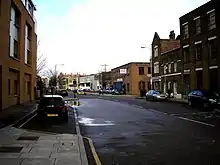
Conservation Areas
Bethnal Green has a number of conservation areas established by Tower Hamlets Council due to its history and landscape, including the Bethnal Green Gardens Conservation Area which was designated in July 1969 and then extended in October 2008 to the south west of the tube station due to significant buildings located in and around the junction of Bethnal Green Road, Roman Road and Cambridge Heath Road, which helps ensure these landmarks will be preserved.[42]
A part of the Hackney Road Conservation Area is intended to protect the special architectural and historic character of buildings and areas adjoining the road which are composed of a dense concentration of modest sized properties.[64] The Victoria Park Conservation Area was designated in March 1977, altered in 2008 to make way for the Regent's Canal Conservation Area and to expand Driffield Road Conservation Area and now includes the listed park itself, the formal axial road pattern to the south west and the many Victorian terraces.[65]
It is also part of the wider Regents Canal Conservation Area, the streetside buildings are neglected but form part of the industrial heritage and character of Vyner Street and also Wadeson Street, which contains a row of three storey Victorian workshops mostly converted to residential use. Both types contribute to the character of the area.[66]
To the north-west is the Old Bethnal Green Road Conservation Area, which focuses around the roads of the Winkley Estate, which has a very cohesive character and little scope exists for change. The buildings contained within the area being considered form an important group worthy of protection and enhancement.[67]
Parks
Bethnal Green Gardens, located in central Bethnal Green, holds the war memorial, known as the Stairway To Heaven,[68] and Weavers' Fields, which is a 15.6 acres park and is the 6th largest open space in Tower Hamlets that lies south of Bethnal Green Road.[69] The western part of Victoria Park is in Bethnal Green.
In the 1970s, Tower Hamlets Council decided to fence and lock up the area now known as Bethnal Green Nature Reserve, to protect it from fly tipping. In the late 1990s the local Teesdale and Hollybush Tenants and Residents Association became the site custodians and, with the support of Tower Hamlets Council, took responsibility for St Jude's as it was still called locally.[70]
Notable buildings
The former Bethnal Green Infirmary, later the London County Council Bethnal Green Hospital, stood opposite Cambridge Heath railway station. The hospital closed as a public hospital in the 1970s and was a geriatric hospital under the NHS until the 1980s. Much of the site was developed for housing in the 1990s but the hospital entrance and administration block remains as a listed building.
Demographics

Bethnal Green had a total population of 27,849 at the 2011 UK census.[71] The largest single ethnic group is people of Bangladeshi descent, who constitute 38 per cent of the area's population. Every year since 1999 the Baishakhi Mela is held in Weavers' Fields to commemorate the Bengali New Year.[72] The second largest is the White British, constituting 30 per cent of the area's population. Other ethnic groups include Black Africans and Black Caribbeans.[73]
According to the UK census of 2011, the population has a lower proportion of young people than the national average and a higher proportion of older people. Bethnal Green also has a significant immigrant population.[74]
Religion and mysticism
Bethnal Green's residents are around 50 per cent Muslim and 34 per cent Christian.[75]
There are many historic churches in Bethnal Green. Notable Church of England churches include St John on Bethnal Green,[76] which was built from 1826 to 1828 by the architect John Soane, St Matthew – built by George Dance the Elder in 1746. St Matthew is the mother church of Bethnal Green; the church's opening coincided with a vast population increase in the former village of Stepney, resulting in the need to separate the area around Bethnal Green from the mother Parish of St Dunstan's, Stepney. All but the bell tower, still standing today, was destroyed by fire and the church again suffered devastating damage during the bombing campaigns of the Second World War, resulting in the installation of a temporary church within the bombed-out building. St. Matthew's remains a major beacon of the local East End community and is frequented on Sundays and other religious occasions by a mixture of established locals and more recent migrants to the area.[77] Other churches include St Peter's (1841) and St James-the-Less (1842), both by Lewis Vulliamy, St James the Great by Edward Blore (1843) and St Bartholomew by William Railton (1844). The church attendance in Bethnal Green was 1 in 8 people since 1900 (only 10% attend regularly in the UK). Baptisms, marriages and burials have been deposited nearly at all churches in Bethnal Green.[78][79]
There is one major Roman Catholic church, the Church of Our Lady of the Assumption,[80] in Bethnal Green. The Church of Our Lady of the Assumption hosts the London Chinese Catholic Centre and Chinese mass is held weekly.[81] Other Christian churches include The Good Shepherd Mission,[82] The Bethnal Green Medical Mission,[83] The Bethnal Green Methodist Church.[84] The Quakers hold regular meetings in Old Ford Road.[85] Opened and named after the parish of Bethnal Green, in 1868, the Bethnal Green Methodist Church became tied in with the founding of the National Children's Home and Orphanage (now Action for Children). This was established next to the church on Bonner Road.[86]
St. Casimir's Lithuanian Church serves London's Lithuanian community and masses are held in both Lithuanian and English.[38][87]
There are at least eight Islamic mosques or places of worship in Bethnal Green for the Muslim community.[88] These include the Baitul Aman Mosque and Cultural Centre,[89] Darul Hadis Latifiah,[90] the Senegambian Islamic Cultural Centre and the Globe Town Mosque and Cultural Centre.
The London Buddhist Centre works with those affected by alcohol dependency,[91] the centre also runs courses and retreats using mindfulness based cognitive therapy approaches. Its courses for depression, based on the mindfulness-based cognitive behavioral therapy methodology of Jon Kabat-Zinn at the University of Massachusetts Medical School, featured in the Financial Times in 2008.[92] It is the focus of a large Buddhist residential and business community in the area.[92]
In the Boundary Estate, Arnold Circus is a mark point on several ley line alignments, such as for example the Alfred Watkins' "Strand Ley"[93] and "The Coronation Line".[94]
.jpg.webp)
Public Services
Health
The Bethnal Green and Globe Town Community Mental Health Team (CMHT) is a community-based multidisciplinary team; they provide a health and social care for service users with severe and enduring mental health problems, run by East London NHS Foundation Trust (ELFT).[95]
Education

Bethnal Green has numerous primary schools, educating children aged four to 11. St. Matthias School, on Bacon Street off Brick Lane, is over a century old and uses the Seal of the old Metropolitan Borough as its badge and emblem. The school was opened with funds from 18th-century St. Matthew's Church on St. Matthew's Row.[96] The Bangabandhu Primary School, named after the father of Bangladesh, Sheikh Mujib, a non-selective state community school,[97] was opened in January 1989; it moved to a new building in November 1991 and has over 450 pupils. In the first decade, around 70% of pupils' parents spoke English as a second language; instead speaking Sylheti, a dialect of Bengali, at home, and Standard Bengali is a subject choice in the school.
Bethnal Green Academy is one of the top schools and sixth form colleges in London. Other schools in the area include Oaklands School.
The oldest secondary school was Raine's Foundation School on Old Bethnal Green, a voluntary aided, Anglican-tradition, state school founded in 1719.[98] The school relocated, amalgamating with St. Jude's School[99] to become coeducational in 1977. The school closed in 2020.
Bethnal Green Gardens and Bethnal Green Library provide leisure facilities and information.
Voluntary and community services
The Oxford House is a proactive community centre that has its roots in helping the local community. Founded in 1884, as one of the first "settlements" by Oxford University,[100] it has helped alleviate or remove the impact of poverty and today still remains a focus point by providing a programme of community classes, events and weekly activities.[101]
The Approach Gardens, once an unused space, has been developed into a community food garden, a shared fruit orchard and a wildlife area.[102]
The Nomadic Community Gardens, once an area fenced off and overgrown, was occupied between 2015 and 2019[103] by a temporary project or "meanwhile use" run by a private limited company[104] on behalf of the property developer Londonewcastle, which leases the site to the garden operator for a peppercorn rent and provided start-up funding.[105] Londonewcastle gained planning consent for a development of "affordable housing, townhouses and apartments"[106] on the site in November 2015.[107] Construction on the Fleet Street Hill Project was intended to commence in 2016.[105] In 2019 ownership of the lease was sold;[103] the site currently remains empty.
The Gallery Cafe, in St. Margaret's House, reopened as a vegetarian not-for-profit, community café in 2006; it became a fully vegan café in December 2017.[108] It won Best Café in Bethnal Green at the Time Out Love London Awards in 2014, 2015 [109] and 2016.[110]
Transport
Railway
Bethnal Green tube station is on the London Underground Central line, which connects Bethnal Green directly to Stratford in the east, the City and London's West End.
The area is also linked to the National Rail network at two stations on the London Overground network: Bethnal Green and Cambridge Heath railway stations.[111][112]
In 2018, Cambridge Heath station was chosen for a trial with a pay-by-face system that may end the need for station barriers, due to its low passenger volumes and having no gates.[113]
Bethnal Green has also been part of the Night Tube service since 2016.[114]
Buses
Bethnal Green is served by London Buses, including route 8, 26, 55, 254 and 388 to Central London; routes 309, 388, D3, D6 and night routes N8, N26, N55 and N243 also stop here.[115]
The 26 bus route was introduced in 1992 to replace the withdrawn section of route 6 between Hackney Wick and Aldwych and included a new night counterpart to Chingford from Hackney Wick, the N26.[116]
On 25 September 1993, route 309 started running between Bethnal Green and Poplar. It was intended to start from the London Chest Hospital but this was delayed due to speed hump problems and it therefore started and ended at Three Colts Lane instead. It was finally extended from Bethnal Green station to Chest Hospital in 1995.[117]
Art and memorials
Clare Street is well known as an art quarter. Some of the murals there have the buildings' owners' permission.[118] Elsewhere, a mural of David Attenborough appeared on the side of a tropical fish store on St Matthew's Row.[119]
Chris Gollon gained a major commission from the Church of England for fourteen Stations of the Cross paintings for the St John church.[120] Gollon was a controversial choice, since he is not a practising Christian. In order to carry out the commission, and for consultation on theological matters, he collaborated with Fr Alan Green, Rector of the church.[121]
Between 2005 and 2008, the EEL (East End Life) established the Vyner Street Festival with the local Victory Pub as a family festival with local bands, artists and market traders, this has a different theme every year, with the Red Arrows performing flyover in 2008.[122] By 2012, however, many artists had moved out due to the effects of the Great Recession as well as the 2012 Olympics.[123] A documentary film was released in the same year titled Vyner Street: this was a short observational piece about two different worlds living inconspicuously and side by side in the same place.[124][125][123]
As part of "TUBE" Art Installation in November 2013, sound artist Kim Zip[126] created an installation[127] commemorating the Bethnal Green Tube Disaster. The work was backed by the Whitechapel Gallery and promoted as part of the organisation's "First Thursdays" initiative for popular art.[128] "TUBE" exhibited over a period of four weeks in the belfry of Sir John Soane's St John on Bethnal Green Church.[129] The Lady Dinah's Cat Emporium was the first cat café in London, which was opened in 2013.[130][131]
The Oval Space hosted Catfest in 2018, with guests having the chance to take photos with cats as well as sample street food and meet shelter kittens.[132][133]
A plaque was placed at the entrance to the tube station in the 1970s to commemorate the disaster there, one of the worst of the Second World War; and a larger memorial, "Stairway to Heaven", stands in nearby Bethnal Green Gardens. This memorial was unveiled in December 2017 at a ceremony attended by Mayor of London Sadiq Khan and Bethnal Green and Bow MP Rushanara Ali.[134]
Employment and gentrification
In 2019 Sustrans opened a new London headquarters at Bethnal Green.[135]
Early in 2018 Frank Wang, who had sold coffee to commuters from his van at the northern exit of Bethnal Green underground station lost his business when the electricity supply from the station was cut off as a result of the nearby site of a disused public lavatory behind his stall being converted into a beach bar called Chiringuito.[136] Tower Hamlets Mayor John Biggs, one of Frank's long-standing customers came out in support along with the local community, the Chinese community and commuters who protested.[137]
Formerly part of the estate of Truman's Brewery, now a free house,[138][139] The Hare was cited as the epitome of a ‘good, honest pub’ by the Evening Standard and was listed as one of the 50 best pubs in London in 2019.[140] During the May bank holiday, the redeveloped railway arches off Cambridge Heath Road into an eating and drinking quarter opened.[141] Tower Hamlets Council had turned down plans for the Cambridge Heath Road development because of concerns over its affordable housing mix and design quality.[142] The Better Streets for Tower Hamlets had turned the car park spot in Bethnal Green Road into a mini park for a day to draw people's attention to the need for more healthier public spaces.[143]
In 2018 Sainsbury's opened what it claims was the country's first meat-free butchers, in the form of a traditional style butchers which was open for three days from Friday 21 June to mark World Meat Free Week, where it offered customers an array of cuts and joints derived from plant-based alternatives, such as mushroom, jackfruit and pea protein.[144] During the 2019 redecorating of the Carpenters Arms on Cheshire Street, an old safe was found in the cellar when a wall was torn down. It is thought it was boarded up before the immediately previous owners has acquired the pub.[145]
Notable people
- Roger Crab (1621-1680), a promoter of Christian vegetarianism, who lived as a hermit at Bethnal Green.
- Shamima Begum, a British-Bangladeshi woman who went to marry an ISIL member, was born and raised here.[146]
- Pete Doherty and Carl Barât of the Libertines lived and performed gigs in a flat in Bethnal Green they called The Albion Rooms.[147]
- Leslie Fuller, nationally famous film star (One Good Turn), once lived at 14, Pollard Row.
See also
References
- Census Information Scheme (2012). "2011 Census Ward Population figures for London". Greater London Authority. Retrieved 17 October 2023.
- T F T Baker, ed. (1998). "A history of the county of Middlesex, volume 11, Stepney, Bethnal Green – Bethnal Green: settlement and building to 1836". pp. 91–95.
- Lysons, Daniel (1795). The Environs of London: Volume 2, County of Middlesex. London: T Cadell and W Davies. pp. 27–38.
- Mills, A.D. (2010). A Dictionary of London Place-Names (2 ed.). Oxford University Press. ISBN 9780199566785.
- Young's guide describes Hamlets as devolved areas of Parishes - but does not describe this area specifically Youngs, Frederic (1979). Guide to the Local Administrative Units of England. Vol. I: Southern England. London: Royal Historical Society. ISBN 0-901050-67-9.
- Joel Gascoyne's maps of Stepney in 1703 show the hamlets of the parish occupying the same boundaries as when they subsequently became independent parishes
- "Bethnal Green - Local Government". A History of the County of Middlesex: Volume 11: Stepney, Bethnal Green. 1998. Retrieved 13 August 2010.
- The London Gazette Issue: 21802. 20 October 1855. pp. 3881–3882. Retrieved 9 April 2015.
- "H.M.S.O. Boundary Commission Report 1885 Bethnal Green Map". Vision of Britain. Retrieved 9 April 2015.
- "Cambridge Heath - eastlondonhistory.com". eastlondonhistory.com.
- Baker, T. F. T., ed. (1998). "Stepney: Settlement and Building to c.1700". A History of the County of Middlesex: Volume 11, Stepney, Bethnal Green. pp. 13–19. Retrieved 6 December 2021.
{{cite book}}:|website=ignored (help)CS1 maint: location missing publisher (link) - Robinson and Chesshyre 1986, p. 31.
- "Blind Beggar of Bethnal Green". www.eastlondonhistory.com. Archived from the original on 30 October 2007.
- Nichols, Beverley, ed. (1934). A Book of Old Ballads. London: Hutchinson & Sons.
- Baker, T. F. T., ed. (1998). "Bethnal Green: Social and Cultural Activities". A History of the County of Middlesex: Volume 11, Stepney, Bethnal Green. pp. 147–155. Retrieved 25 September 2022.
{{cite book}}:|website=ignored (help)CS1 maint: location missing publisher (link) - Beningfield, T. J. (1964). London 1900–1964. Armorial Bearings and Regalia of The London County Council, The Corporation of London and The Metropolitan Boroughs. London: E. J. Burrow. pp. 49–50.
- Crosley, Richard (1928). London's Coats of Arms and the Stories they Tell. London: Robert Scott. pp. 46–49.
- Crosley, Richard (1928). London's Coats of Arms and the Stories they Tell. London: Robert Scott. pp. 47–51.
- History of the mulberry in London https://www.moruslondinium.org/research/timeline
- Spitalfields Life website https://spitalfieldslife.com/2018/02/19/the-bethnal-green-mulberry-lecture/
- "Bare-Knuckle Fighter". Antiques Roadshow Detectives. Series 1. Episode 3. 8 April 2015. BBC Television. Retrieved 19 April 2015.
- The Green, Land assessments records, Gascoyne's survey of 1703.
- Bethnal Green Business Forum (2014). "History". Archived from the original on 2 September 2018. Retrieved 1 June 2019.
{{cite web}}:|last=has generic name (help) - 'Bethnal Green: Building and Social Conditions from 1876 to 1914', A History of the County of Middlesex: Volume 11: Stepney, Bethnal Green (1998), pp. 126–32 accessed: 14 November 2006.
- "Timeline". Archived from the original on 19 August 2012. Retrieved 10 January 2012.
- "Our history". Archived from the original on 23 January 2012. Retrieved 10 January 2012.
- "Cambridge Heath | Hidden London". hidden-london.com. Retrieved 27 August 2020.
- London Borough of Tower Hamlets (4 November 2009). "Regent's Canal" (PDF). Retrieved 2 June 2019.
- From 1801 to 1821, the population of Bethnal Green more than doubled and by 1831 it had trebled. These incomers were principally weavers. For further details see: Andrew August Poor Women's Lives: Gender, Work and Poverty in Late-Victorian London pp 35–6 (Fairleigh Dickinson University Press, 1999) ISBN 0-8386-3807-4
- 'Bethnal Green: Building and Social Conditions from 1837 to 1875', A History of the County of Middlesex: Volume 11: Stepney, Bethnal Green (1998), pp. 120–26 Date accessed: 21 January 2007.
- 'Spitalfields', Old and New London: Volume 2 (1878), pp. 149–52 accessed: 8 February 2007.
- Forgotten Stations of Greater London by J. E. Connor and B. Halford.
- Taylor, D J (July 1990). "Cambridge Heath Station". Great Eastern Journal. 63: 11.
- Wilson, Bryan (October 2002). "Hackney Downs Station, Middlesex". Great Eastern Journal. 112: 21, 22.
- Hoole, Ken (1982). Trains in Trouble: Vol. 3. Redruth: Atlantic Books. p. 39. ISBN 0-906899-05-2.
- "Accident at Bethnal Green on 17th June 1962" The Railways Archive accident report 21 December 1962; Retrieved 12 May 2017.
- "Mowlem Primary - History". www.mowlem.org.uk.
- Catholic Churches of London by Denis Evinson, 1998, ISBN 1-85075-819-0
- "The Civic Plunge Revisited" (PDF). Twentieth Century Society. 24 March 2012. Archived (PDF) from the original on 9 August 2016. Retrieved 25 April 2020.
- Boxing: Harrison calls for York Hall reprieve Sandra Laville (The Daily Telegraph) accessed 7 December 2007.
- "Hotel review | Town Hall, London". the Guardian. 30 July 2010.
- London Borough of Tower Hamlets (4 November 2009). "Bethnal Green Gardens" (PDF). Archived from the original (PDF) on 11 April 2018. Retrieved 31 May 2019.
- Oakley, Malcolm (7 October 2013). "World War 2 and East London". East London History. Retrieved 31 May 2019.
- Julia Gregory (27 August 2010). "East End library remembers the Blitz". Eastern Daily Press. Norwich. Archived from the original on 9 July 2018. Retrieved 31 May 2019.
- "The Blitz". Oxford House. Archived from the original on 9 July 2018. Retrieved 23 August 2018.
- Bethnal Green: Building and Social Conditions from 1915 to 1945, A History of the County of Middlesex: Volume 11: Stepney, Bethnal Green (1998), pp. 132–135 accessed: 10 October 2007.
- "Families kept away by World War II bomb". BBC News. 16 May 2007. Retrieved 16 May 2007.
- Simon B (29 July 2002). "The Bethnal Green tube shelter disaster". BBC. Retrieved 20 June 2019.
- Skibbereen Eagle. "Bethnal Green tube disaster". Southern Star. Skibbereen, Co. Cork. Archived from the original on 20 June 2019. Retrieved 20 June 2019.
- A London Inheritance (6 May 2018). "Bethnal Green's Ordeal". Retrieved 20 June 2019.
- National Archives. "Why did the Bethnal Green tube shelter disaster happen?". Retrieved 20 June 2019.
- Bolger, Peter; Hepplewhite, Peter (2019). "Lemonade factory air raid disaster 1941". North Shields 173. Retrieved 2 June 2019.
- Chopra, Arya (21 September 2017). "14 amazing facts about the Kray twins".
- Windows Blown Out Of Number 26 Bus Sky News 21 July 2005.
- Defence Correspondent, Lucy Fisher (13 February 2019). "Bethnal Green trio fled Britain with help from Isis's best female recruiter". The Times. ISSN 0140-0460. Retrieved 23 February 2019.
- Saltman, Erin Marie; Smith, Melanie (2015). 'Till Martyrdom Do Us Part' Gender and the ISIS Phenomenon (PDF). Institute for Strategic Dialogue. p. 4. Archived from the original (PDF) on 30 March 2016. Retrieved 25 February 2016.
- Craig, F.W.S., ed. (1969). British parliamentary election results 1918-1949. Glasgow: Political Reference Publications. p. 8. ISBN 0-900178-01-9.
- "Rushanara Ali MP". UK Parliament.
- "Bethnal Green Ward Profile" (PDF). towerhamlets.gov.uk. Archived (PDF) from the original on 27 August 2019.
- "St Peter's Ward Profile" (PDF). towerhamlets.gov.uk. Archived (PDF) from the original on 27 August 2019.
- "Your Councillors". democracy.towerhamlets.gov.uk. 20 March 2021. Retrieved 20 March 2021.
- "Your Councillors". democracy.towerhamlets.gov.uk. 20 March 2021. Retrieved 20 March 2021.
- Tower Hamlets Borough Council Election Maps 1964–2002 Archived 4 October 2006 at the Wayback Machine accessed 14 April 2007.
- London Borough of Tower Hamlets (4 November 2009). "Hackney Road" (PDF). Archived (PDF) from the original on 17 May 2017. Retrieved 2 June 2019.
- London Borough of Tower Hamlets (4 November 2009). "Victoria Park" (PDF). Archived (PDF) from the original on 4 September 2019. Retrieved 2 June 2019.
- "Regents Canal Conservation Area" (PDF). Tower Hamlets. Retrieved 16 June 2019.
- London Borough of Tower Hamlets (4 November 2009). "Old Bethnal Green Road" (PDF). Archived (PDF) from the original on 21 May 2017. Retrieved 31 May 2019.
- London Borough of Tower Hamlets. "Bethnal Green Gardens". Retrieved 21 June 2019.
- The Oxford House in Bethnal Green. "Weavers Fields". Love Bethnal Green. Retrieved 2 June 2019.
- "Location". Phytology. Retrieved 27 August 2020.
- Services, Good Stuff IT. "Tower Hamlets – UK Census Data 2011". UK Census Data. Retrieved 13 May 2016.
- London Town, May 2009 Archived 23 December 2009 at the Wayback Machine Retrieved on 2009-04-29.
- Services, Good Stuff IT. "Bethnal Green South – UK Census Data 2011". UK Census Data.
- "Socio-economic statistics for Bethnal Green, Tower Hamlets". 7 May 2011.
- Neighbourhood Statistics. "ONS". Neighbourhood.statistics.gov.uk. Archived from the original on 11 May 2012. Retrieved 27 November 2011.
- "St John on Bethnal Green". Archived from the original on 26 July 2012. Retrieved 12 August 2012.
- St Matthew's. "St Matthews". Retrieved 1 June 2019.
- Susan Gane (Summer 2007). "Bethnal Green Churches". London Society Journal (453). Archived from the original on 4 October 2011. Retrieved 27 November 2011.
- "EoLFHS Parishes: Bethnal Green". Archived from the original on 19 August 2009.
- "Our Lady of the Assumption". Retrieved 13 February 2016.
- "London Chinese Catholic Centre". Retrieved 13 February 2016.
- "Good Shepherd Mission". Good Shepherd Mission. Retrieved 13 February 2016.
- "Bethnal Green Medical Mission". Bethnal Green Mission Church. Archived from the original on 26 August 2016. Retrieved 13 February 2016.
- "Methodist Church in Tower Hamlets, Bethnal Green Meeting". The Methodist Church in Tower Hamlets, Bethnal Green Meeting. Archived from the original on 11 July 2016. Retrieved 13 February 2016.
- "Bethnal Green Friends". Bethnal Green Quaker Meeting. Archived from the original on 20 January 2017. Retrieved 13 February 2016.
- Brooke, Mike (4 April 2018). "Worshippers celebrate 150th anniversary of Bethnal Green Methodist Church". East London Advertiser.
- "St Casimir's Lithuanian Church". Official website. Retrieved 24 February 2015.
- Tahire Mehmood Faruq. "Mosque Directory". Archived from the original on 23 August 2018. Retrieved 13 February 2016.
- "Services of Baitul Aman Mosque". Archived from the original on 16 January 2009.
- "Darul Hadis Latifah". Darul Hadis Latifiah. Archived from the original on 6 October 2011. Retrieved 27 November 2011.
- "Buddha and the bottle", The Times, 11 August 2007.
- "Meditation or medication?", Financial Times, 6 April 2008, archived from the original on 10 December 2022
- Alfred Watkins The Old Straight Track (Abacus, 1994) ISBN 0-349-13707-2
- Chris Street Earthstars: The Visionary Landscape (Hermitage Publishing, 2001) ISBN 0-9515967-1-3
- "Idea Store Directory". www.ideastoreonlinedirectory.org.
- "Ofsted inspection report for Saint Matthias School". Ofsted. Retrieved 5 February 2009.
- "A-Z Services – Tower Hamlets". Archived from the original on 26 September 2006.
- Bell, Walter George (1966). Unknown London. London: Spring Books. p. 326. ISBN 9787250010263.
- Johnson, Malcolm (2001). Bustling Intermeddler? The Life and Works of Charles James Blomfield. Gracewing. p. 109. ISBN 0-85244-546-6.
- Koven, Seth (2004). Slumming: sexual & social politics in Victorian London. Princeton University Press. p. 229. ISBN 0-691-11592-3.
- The Oxford House in Bethnal Green. "About Oxford House". Archived from the original on 31 May 2019. Retrieved 31 May 2019.
- London Parks and Gardens Trust (1 June 2019). "Approach Gardens". Archived from the original on 1 June 2019. Retrieved 1 June 2019.
- Sims, Alexandra (20 September 2019). "You've only got 8 days to visit Nomadic Community Gardens before it closes for good". Time Out London. Retrieved 21 January 2021.
- "NOMADIC COMMUNITY GARDENS LTD - Overview (free company information from Companies House)". beta.companieshouse.gov.uk. Retrieved 27 June 2019.
- "Meet the Londoners who are setting up new pop-up villages in London's empty building sites". Homes and Property. 20 October 2015. Retrieved 27 June 2019.
- "Fleet Street Hill | Londonewcastle". londonewcastle.com. Retrieved 27 June 2019.
- Waite, Richard (25 November 2015). "Appeal victory for Partington and Barber in Shoreditch". Architects Journal. Retrieved 27 June 2019.
- Fat Gay Vegan, "London Cafe Turns Totally Vegan", 8 January 2018. Accessed 31 August 2018.
- Clack, David: "Love London Awards 2015 And The Winners Are", Time Out, 17 November 2015. Accessed 31 August 2018.
- Clack, David (15 November 2016). "The Time Out Love London Awards 2016". Time Out. Retrieved 21 June 2019.
- TFL appoints London Overground operator to run additional services Transport for London 28 May 2014
- TfL count on LOROL for support Rail Professional 28 May 2014
- "Could scanners like these solve Tube and train crowds?". Evening Standard. 22 November 2018.
- Transport for London (2 June 2019). "Bethnal Green Underground Station". Retrieved 2 June 2019.
- "Stops in Bethnal Green". Bus Times. 2023. Retrieved 2 June 2023.
- Blacker, Ken (2007). Routemaster: 1970–2005. Vol. 2 (2nd ed.). Harrow Weald: Capital Transport. p. 118. ISBN 978-1-85414-303-7.
- Armstrong, Ian (26 April 2018). "London Bus Routes 1934–2019: 309". Retrieved 1 June 2019.
- Inspiring City (24 September 2016). "The street art of Clare Street in Bethnal Green". Retrieved 21 June 2019.
- Brooke, Mike (5 May 2019). "How David Attenborough's global warming message turned into Bethnal Green street mural". East London Advertiser. Retrieved 27 August 2020.
- "Stations of the Cross". St John on Bethnal Green. Retrieved 12 August 2012.
- Pickeral, Tasmin (2010). Chris Gollon: Humanity in Art. Hyde & Hughes. p. 170. ISBN 978-0-9563851-0-9.
- "VYNER STREET FESTIVAL". 28 January 2010.
- Batty, David (6 June 2012). "East End art galleries forced to go west as local scene 'dies'". The Guardian. London.
- Internet Movie Database (2019). "Vyner Street (2012)". IMDb. Retrieved 21 June 2019.
- Gleadell, Colin (29 May 2005). "Art sales: building a new art hub". Daily Telegraph. London. Archived from the original on 12 January 2022.
- "Bomb Everyone". Bomb Everyone website. 1 January 2011. Archived from the original on 3 July 2013.
- "Remembrance art marks Bethnal Green's 1943 air-raid shelter disaster". East London Advertiser. 4 November 2013. Archived from the original on 24 May 2014.
- "Whitechapel Gallery's First Thursdays". Whitechapel Gallery. 31 October 2013. Archived from the original on 24 May 2014.
- "Kim Zip Presents TUBE on Soundcloud". Soundcloud. 1 November 2013.
- Rusk, Connie (23 July 2017). "Take a sneak peek into London's very own cat café".
- "London's first cat café gets green light". Independent.co.uk. 13 September 2013.
- "Paw blimey! A cat festival is coming to London". 12 July 2018.
- "Stop the mewsic: A cat festival is coming to London". Time Out London. 17 October 2017.
- "Bethnal Green – disaster at the tube, Wednesday 24 September 2003, 19.30 BBC Two". Archived from the original on 13 December 2007.
- Brooke, Mike (9 May 2019). "Cycle charity makes its big move to Bethnal Green carrying its office on cargo bikes". East London Advertiser. Retrieved 27 August 2020.
- "'Keep Frank's coffee stand open'". BBC News.
- Brooke, Mike (8 August 2018). "Protest frothing up to save Frank Wang's coffee stall outside Bethnal Green tube station". East London Advertiser.
- Pub History (24 May 2019). "Hare, 505 Cambridge Heath Road, Bethnal Green E2". Retrieved 21 June 2019.
- "Hare, Bethnal Green". whatpub.com.
- "The 50 best pubs in London". Evening Standard. 11 January 2019.
- "The Arches is Bethnal's Green's newest eating and drinking quarter". Hot Dinners. 7 May 2019. Retrieved 27 August 2020.
- Dunton 2019-05-24T05:00:00+01:00, Jim. "189-home scheme rejected over affordable housing quota". Housing Today. Retrieved 27 August 2020.
- King, Jon (20 May 2019). "Campaigners turn Bethnal Green Road parking bay into 'parklet' in streets protest". East London Advertiser. Retrieved 27 August 2020.
- Mannering2019-06-24T11:12:00+01:00, Robin. "Sainsbury's reacts to customer trends with 'UK's first' meat-free butchers". Convenience Store. Retrieved 27 August 2020.
- Morris, Deborah (15 January 2019). "Pub once owned by Kray twins has a safe inside which hasn't been opened". MyLondon. Retrieved 27 August 2020.
- Mohdin, Aamna (14 February 2019). "Let Shamima Begum come back, say Bethnal Green residents". The Guardian. ISSN 0261-3077. Retrieved 21 February 2019.
- "The Libertines play the Albion Rooms". The Guardian. 13 June 2011. Retrieved 20 November 2020.
Further reading
- Robinson, A. J.; Chesshyre, D. H. B. (1986). The Green: a history of the heart of Bethnal Green and the legend of the Blind Beggar (2nd ed.). London: London Borough of Tower Hamlets. ISBN 0-902385-13-5.
External links
- "Tower Hamlets London Borough Council information about Bethnal Green". Archived from the original on 9 November 2005.
- Chisholm, Hugh, ed. (1911). . Encyclopædia Britannica. Vol. 3 (11th ed.). Cambridge University Press.
